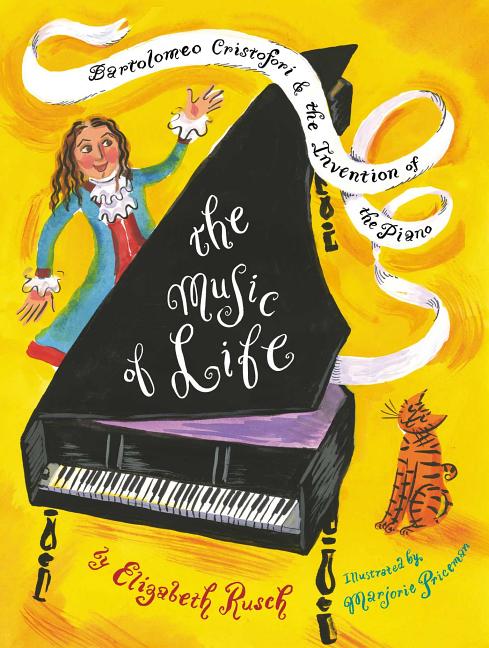Book Descriptions
for The Music of Life by Elizabeth Rusch and Marjorie Priceman
From Cooperative Children's Book Center (CCBC)
Bartolomeo Cristofori, master instrument maker and tuner for the Medici family in 18 th -century Italy, had an ear finely tuned to the notes of the quiet clavichord and robust harpsichord as well as many other instruments. Unfortunately, no matter how the notes were struck, the clavichord made only soft sounds, and the harpsichord only loud ones. Inspired by violins and violas, Cristofori set out to invent a keyboard instrument that could achieve the same range of volume. He experimented with hammers, strings, and other materials before crafting his first pianoforte—an instrument that he continued to refine until his death, but which wasn’t fully appreciated until years later. Accompanied by bright, playful illustrations, each section of the narrative includes musical direction tracking the story’s arc: “Crescendo (becoming louder)” as Cristofori begins his employment at court, for example. Frequent, direct quotations from primary sources are included on several pages, and additional resources include a timeline, extensive notes on the author’s primary and secondary sources, and facts about Cristofori’s and modern pianos. A thoroughly researched, engaging account of the instrument’s origin. (Ages 7-10)
CCBC Choices 2018. © Cooperative Children's Book Center, Univ. of Wisconsin - Madison, 2018. Used with permission.
From the Publisher
Award-winning biographer Elizabeth Rusch and two-time Caldecott Honor–recipient Marjorie Priceman team up to tell the inspiring story of the invention of the world’s most popular instrument: the piano.
Bartolomeo Cristofori coaxes just the right sounds from the musical instruments he makes. Some of his keyboards can play piano, light and soft; others make forte notes ring out, strong and loud, but Cristofori longs to create an instrument that can be played both soft and loud.
His talent has caught the attention of Prince Ferdinando de Medici, who wants his court to become the musical center of Italy. The prince brings Cristofori to the noisy city of Florence, where the goldsmiths’ tiny hammers whisper tink, tink and the blacksmiths’ big sledgehammers shout BANG, BANG! Could hammers be the key to the new instrument?
At last Cristofori gets his creation just right. It is called the pianoforte, for what it can do. All around the world, people young and old can play the most intricate music of their lives, thanks to Bartolomeo Cristofori’s marvelous creation: the piano.
Bartolomeo Cristofori coaxes just the right sounds from the musical instruments he makes. Some of his keyboards can play piano, light and soft; others make forte notes ring out, strong and loud, but Cristofori longs to create an instrument that can be played both soft and loud.
His talent has caught the attention of Prince Ferdinando de Medici, who wants his court to become the musical center of Italy. The prince brings Cristofori to the noisy city of Florence, where the goldsmiths’ tiny hammers whisper tink, tink and the blacksmiths’ big sledgehammers shout BANG, BANG! Could hammers be the key to the new instrument?
At last Cristofori gets his creation just right. It is called the pianoforte, for what it can do. All around the world, people young and old can play the most intricate music of their lives, thanks to Bartolomeo Cristofori’s marvelous creation: the piano.
Publisher description retrieved from Google Books.


